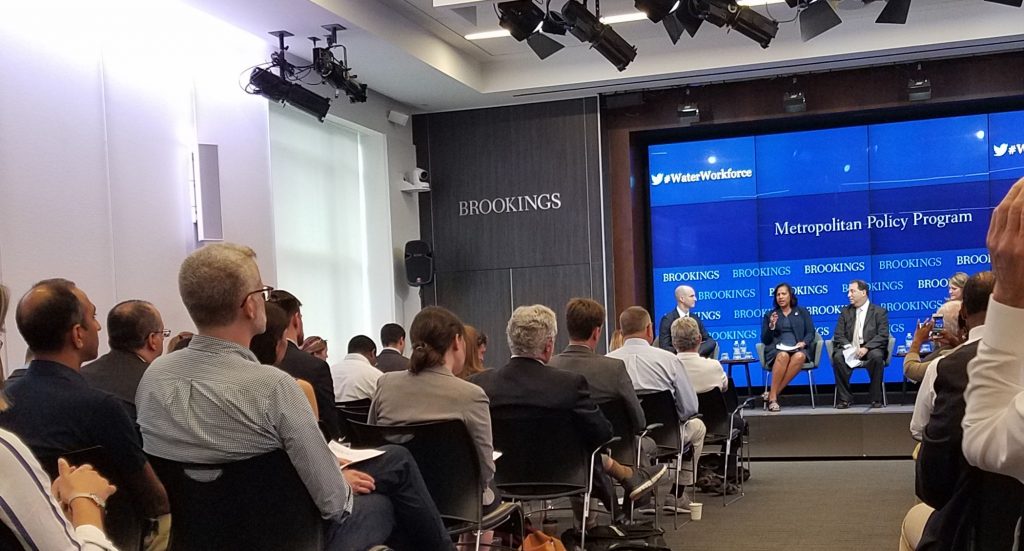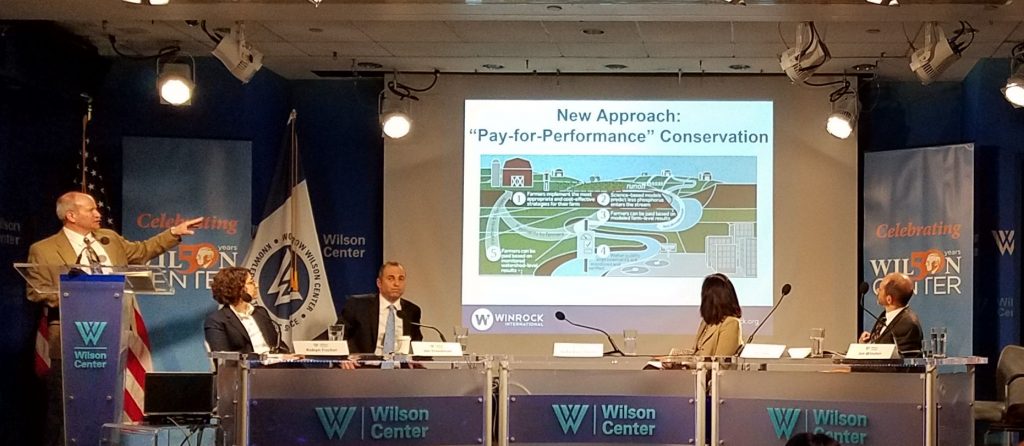My notes from “Water @ Wilson: 50 Years of Water, Conflict & Cooperation
I attended the above conference on November 28. Below are notes.
Water is critical. It grows our food, generates our energy, and ensures our prosperity. To address the challenges that stand in the way of building healthy, prosperous, and peaceful communities, we must first tackle the challenge of water insecurity. As the Wilson Center celebrates its 50th anniversary, the Environmental Change and Security Program marks water’s central role in our work at a special event highlighting innovative approaches to water, health, and security.
A rapidly changing climate and shifting demographics means the future of water resource management may not look like the past:
What is the new face of water conflicts?
Where are the opportunities to secure access to water and create more resilient communities?
How can we protect our oceans from pollution and conflict?
What are governments doing to elevate the importance of water security?
Join us on November 28th as we take stock on the 1st year of the 1st U.S. Global Water Strategy; explore new research and practice on water, peace, and conflict; and highlight the centrality of water to global prosperity.
Introductions
Lauren Risi, Project Director, Environmental Change & Security Program, Wilson Center opened “Water @ Wilson: 50 Years of Water, Conflict, and Cooperation” to an overflow crowd. Every seat in the main auditorium was taken and others watched the video stream in an overflow room. She introduced Jane Harman, Director, President, and CEO, Wilson Center, who emphasized the importance and complexity of water management, referencing experience in her home state of California.
James Peters, Deputy Assistant Administrator and Acting Global Water Coordinator, Bureau for Economic Growth, Education, and Environment (E3), U.S. Agency for International Development
Keynote speaker James Peters, Deputy Assistant Administrator and Acting Global Water Coordinator, Bureau for Economic Growth, Education, and Environment (E3), U.S. Agency for International Development talked about the problems we face today in water management but compared it to the situation fifty years ago. Fifty years ago, he pointed out, we didn’t even have data on water. We have come a long way.
Clean water is an ideal entry point for development, since it not only provides concrete health benefits but also is an organizing principle. Mr. Peters talked about South Korea. Fifty years ago, South Korea was as poor as poor countries of Africa when they decided to provide clean water to everybody. Korea is now among the world’s rich countries. Korea went from aid recipient to self-sufficient to itself an aid donor. This is as it should be. The purpose of aid is not charity but rather to bring recipient countries up. Partnerships not charity makes everyone better off.
Mr. Peters also talked about the Global Water Strategy published last year and its four interconnected strategic objectives:
- Increasing sustainable access to safe drinking water and sanitation services, and the adoption of key hygiene behaviors;
- Encouraging the sound management and protection of freshwater resources;
- Promoting cooperation on shared waters; and,
- Strengthening water-sector governance, financing, and institutions.
Aaron Salzberg
Next up was Aaron Salzberg, from State. He covered some of the same ground and gave some figures about how lack of access to clean water impedes development, saying that GDP of some countries could be cut by as much as 6% if water issues remain unaddressed. Water issues also lead to tensions among states, but Salzberg pointed out that actual conflicts among nations based on water are not common. This goes against speculations and fears of “water wars.”
John Matthews, Lead and Co-Founder, Alliance for Global Water Adaptation
John Matthews, Lead and Co-Founder, Alliance for Global Water Adaptation finished the keynotes. Infrastructure, he said, is meant to last decades or even centuries. Unfortunately, they are often built with ephemeral political or short-term analysis in mind. He mentioned the Kariba Dam that straddles the border between Zimbabwe and Zambia. It was already obsolete when it was completed in 1977, and since has gotten worse. It just is not designed for condition. He compared this to the Dujiangyan water project in China that has been working since around 256 BC. The difference is that the Dujiangyan project took cultural and natural ecology into account and was robust to change.
You need not leave the USA to see problems of planning gone wrong. A classic example is the Colorado River. Decisions about water allocation were made with data from only a few years and those years were usually wet. This means that more than 100% of the usual flow of the Colorado was allocated. The problem we face now is that the past may be less useful in predicting the future, given rapidly changing climate.
We also need to change how we plan large projects in general. The paradigm of the past was engineering dominant and top-town. Experts determined what to do and where to do it and then executed around that one thing. Today we need to take into account many more stakeholders, as well as factors like demography, urbanization, climate change and change in general. We build infrastructure today for a world of tomorrow that might be very different. Beyond that, the infrastructure itself is likely to be a catalyst for change. Consider again the Colorado River and how the Hoover Dam played an instrumental role in how the whole region developed.
I was reminded of the old saying that yesterday’s solution is today’s problem. This argues for a more incremental decision-making strategy, rather than betting the farm on one throw of the dice. Adjusting might be more useful than a perfect plan.
Mr. Matthews talked about Climate Risk Informed Decision Analysis (CRIDA) and the importance of nature-based solutions – green infrastructure. We build infrastructure to last centuries. It might be a good idea at least to try to think some ways ahead.
Raging Waters: The New Face of Water Conflicts
The program went right into the first panel featuring: Syed Imran Ali, Fellow in Global Health & Humanitarianism, Dahdaleh Institute for Global Health Research, York University; Richard Matthew, Director, Blum Center for Poverty Alleviation, University of California, Irvine; Scott Moore, Senior Fellow, Kleinman Center for Energy Policy, University of Pennsylvania; Janani Vivekananda, Senior Advisor, adelphi and Moderator: Cynthia Brady, Senior Conflict and Peacebuilding Advisor, Center for Resilience, U.S. Agency for International Development.
Scott Moore started off with some myths about water. The good news is that some of the bad news, or at least the bad projections, is wrong. There was a lot of concern that water would lead to international conflicts. It has not. In fact, water scarcity has been more likely to lead to cooperation. The exception is at the subnational level, especially when water access is tied to identity politics, but even this is much less than was feared in the 1990s.
Next up was Richard Mathew (not to be confused with John Matthews above), who talked about how bigger and better data analysis was changing how we can deal with uncertainty. Number crunching that used to take days (if it could be done at all) can now be completed in minutes. The practical effect has been that more scenarios can be run and presented to decision makers. (I am old enough to have done regression analysis by hand and recall that once you did one, you made it fit if at all possible, rather than try alternate scenarios.) It also permits the melding of local knowledge with information developed by experts. Another big advance is the capacity for visualization. We can make maps accurate to a few feet featuring simulations. For example. It is possible to show which streets even what part of a street will be flooded in particular scenarios.
These have been making a difference. A picture is worth 1000 words. When people can see the situation, they can more easily be moved take appropriate action. Mr. Mathew is convinced that this information is saving big money and avoiding lots of suffering, but it is hard to prove a negative. A disaster avoided cannot as easily be counted as the damage of one suffered.
Syed Imran Ali followed. He also talked about the need to know more than immediately meets the eye and talked about a nice, dry field where authorities set up a refugee camp during the dry season. They did not think to ask what the local name meant. It meant “swamp” and when the rainy season came, that it what it became. You have to look at the whole system over time.
Last up was Janani Vivekananda. She used the case of Lake Chad to illustrate the need to get the narrative right. Lake Chad is a big lake in the Sahara Desert. The narrative is that it is shrinking due to climate change and there are expensive plans to pipe water from the Congo River basin. But this narrative is wrong. Lake Chad is currently EXPANDING. It will shrink again. The natural behavior of the lake is to expands and contract with the rains. The challenge is variability. People have adapted to it by varying their activities. They fish in the rainy season and then farm was the lake retreats. The exposed silt is excellent farmland.
A problem here is weak property rights. In many cases, the “records” of property are in the head of some old people, sometimes only one old person. Since all men are mortal, this record is mortal too. The system could be very robust, but the property rights problem remains. The local famers could use dykes, as the Dutch do to create polders, but this investment will not be made if property rights are so weak.
Oceans of Cooperation
A panel on the oceans came after lunch and featured: Rebecca Karnak, Senior Director, Global Public Policy, Dell; Roger Pulwarty, Senior Scientist, NOAA; Mike Sfraga, Director, Global Sustainability and Resilience Program and Polar Institute, Wilson Center; Deirdre Warner-Kramer, Acting Deputy Director, Office of Marine Conservation, U.S. Department of State and Moderator: Sherri Goodman, Senior Fellow, Wilson Center.
Mike Sfraga started off with his “Seven Cs” about the Artic Ocean. He admitted that this was a gimmick but said that it got attention much better. The Seven are climate, commodities, commerce, connectivity, communities, competition & cooperation. Climate change is radically changing the Artic Ocean. A new ocean has been created, with all that entails. So far, there has been decent cooperation among the parties adjacent to the Artic Ocean. Most are friendly, but even the Russians are cooperating. It is one of the few areas where they cooperate about anything. However, this might not last as the riches of the new sea become more apparent and available.
Mr. Sfraga lives in Alaska and he talked about his personal experience with global warming. He has seen whole villages inundated by rising water (or sinking land) or impoverished by changing in animal migration patterns. This will be messy.
Deirdre Warner-Kramer talked about fisheries. It is hard to regulate fishing, since the seas are big and the reach of authorities small. However, fish need to be landed at a port somewhere and at the ports fish catch can be checked. Among the leaders in regulating fishing are small island nations (They have reframed themselves at “large ocean nations.) that have a lot of their national territory at sea. Maybe the best is Iceland. Unfortunately, this cannot be easily scaled.
Roger Pulwarty gave a very lively and amusing presentation. He said that the subject was serious, but we need not be. He talked about the need to plan iteratively as a way to adapt to an uncertain world. He quoted Ruth Bader Ginsberg who said that any change that is sustainable is incremental. He also cautioned against letting yourself be rushed into bad decisions with the quip, “hurry, the lemmings are gaining on us.”
The Future of Water Peace
It was worth it to stay for the last panel of the day, featuring: Ken Conca, Professor of International Affairs, American University; Melissa Ho, Vice President, Fresh Water, World Wildlife Fund; John Parker, Deputy Director, Sustainable Water Partnership (Tetra Tech), and Aaron Wolf, Professor of Geography, Oregon State University with Moderator: Geoff Dabelko, Senior Advisor, Environmental Change & Security Program, Wilson Center; Professor and Director of Environmental Studies, Ohio University
Ken Conca said that he could not predict the future but would speculate that the future will mean more water storage, more recycling of water and more thinking about flooding. All these things are challenging for engineering and social standpoints. Storage, for example, means more reservoirs. Recycling runs into the “yuk factor,” since we are using sewage. We overclean our water now. Of course, drinking water needs be drinking water clean, but there is no useful purpose to super-clean water used to flush toilets or water the grass. There is a lot of resistance to using these.
Mr. Conca also talked about how making decisions needs to adapt. We need to get away from the idea that we have a fixed goal, an end state, but rather see projects as evolving and emerging. Flexibility is more important. For a long time, the economics of scale have been dominant. We built big. Maybe flexibility is overtaking this, and it might be better to do smaller projects and learn. It is a kind of portfolio theory and similar – to extend the financial analogy – to buying stocks over a long period to mitigate risk. Similarly, we should not get too enamored with any one solution. The great promises of the past have usually turned out to work only in limited space. Lots of diversity trumps the big solution.
It is also better not to concentrate power. It is tempting to want to use big power to make big breakthrough, but this is more a triumph of imagination over intelligence. Our messy system of consultation and overlapping authority produces more robust results in the long run. More ideas are proposed and vetted.
Melissa Ho gave case studies from Africa and from the Pantanal in South America. The need is for landscape level solutions. She also advocated green infrastructure. John Parker recounted the case study of the Mara River basin in Kenya and Tanzania.
Aaron Wolf was both encouraging and cautionary. Like some others, he pointed out that the dire prediction of water wars did not come to pass. He only half-joking said that we got into that big worry because the experts who had so-long fought the cold war just needed another big worry to replace the decaying Soviet threat. In fact, hydro-cooperation has been a peace building exercise. Scarcity is not a driver of conflict but can be a drive of cooperation. What matters is resilience of institutions. He pointed out the Israel “ran out of water” in 1968, but in the time since cooperation with Jordan on this issue has improved, despite tensions in other areas.
He talked about the need to communicate with different audiences. Don’t forget that people love water. River festivals are popular. People like to be near water. And don’t forget the spiritual aspect of rivers, water and nature. We post-enlightenment moderns do not much consider this a valid concern, but many others do. In fact, many of us still do too. Interesting. I already ordered his book from Amazon.
Thank you
John Matel







